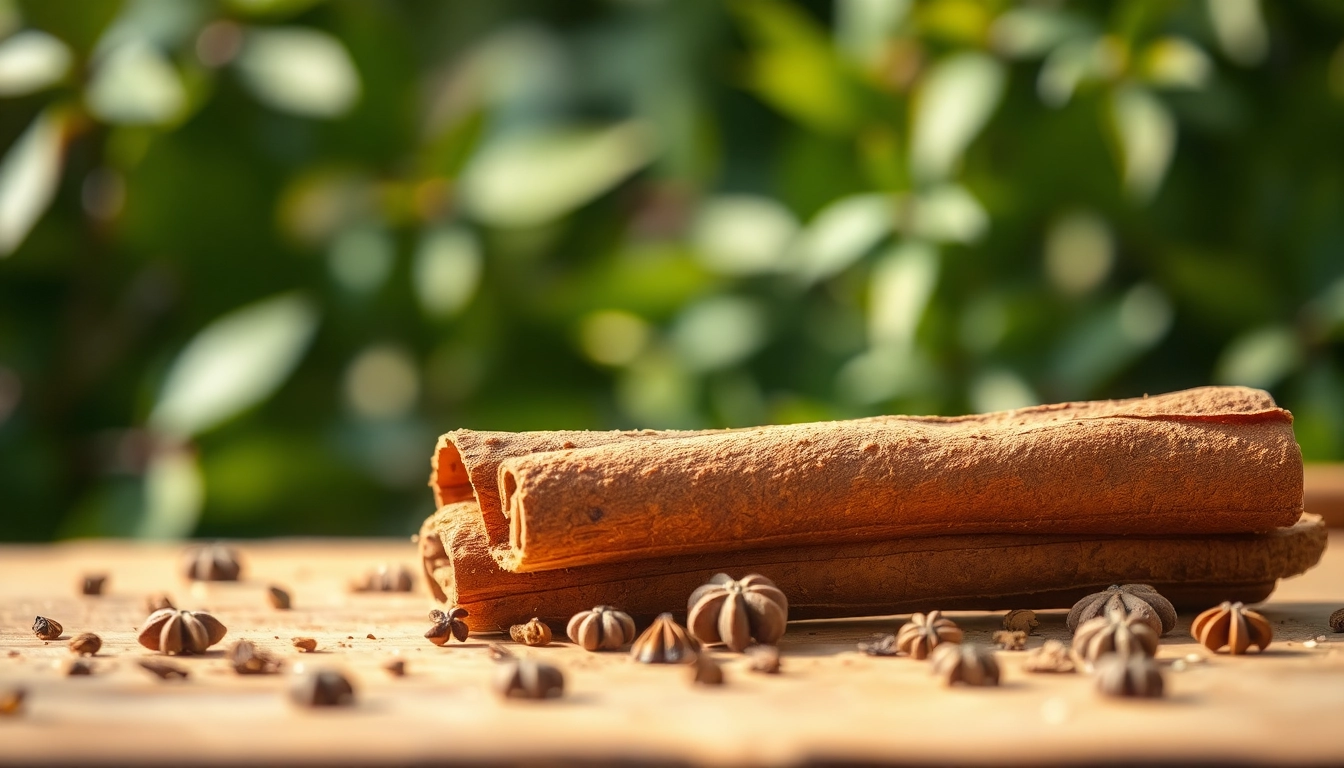The Essential Guide to Cinnamon Bark: Uses, Benefits, and Buying Tips
Introduction to Cinnamon Bark
Cinnamon bark, originating from the genus Cinnamomum, has garnered attention for its distinct flavor, aromatic profile, and potential health benefits. Used for centuries in culinary and medicinal applications, this spice is more than just a kitchen staple; it carries a rich history and an array of benefits that well-versed cooks and health enthusiasts alike appreciate. In this exploration, we delve deeply into what cinnamon bark is, its varieties, its health benefits, culinary uses, and guidance for buying and storing this wonderful spice. Discover more about Cinnamon Bark as we journey through this aromatic world.
What is Cinnamon Bark?
Cinnamon bark is the inner layer of the bark from trees belonging to the Cinnamomum family. When harvested, this layer is dried and curled into quills or ground into powder. The aromatic substance is rich in essential oils and is widely recognized for its sweet flavor and warm aroma. Cinnamon bark is categorized mainly into two types: Ceylon cinnamon, often referred to as “true” cinnamon, and cassia cinnamon, the more commonly found variety. Each has unique characteristics that affect their uses in cooking and medicinal practices.
Historical Significance of Cinnamon Bark
Cinnamon has an extensive history that dates back thousands of years. Ancient civilizations treasured this spice not only for its culinary uses but also for its medicinal properties. The Egyptians used cinnamon in embalming rituals, while in ancient China and India, it was revered in traditional medicine. Trade routes were developed for cinnamon as it became a highly valued commodity, leading to economic booms in countries where it was cultivated. The spice’s rarity and value often resulted in its being a symbol of wealth and luxury.
Varieties of Cinnamon Bark: Ceylon vs. Cassia
The two primary types of cinnamon bark are Ceylon cinnamon (Cinnamomum verum) and cassia cinnamon (Cinnamomum cassia), each showcasing distinct characteristics. Ceylon cinnamon, predominantly sourced from Sri Lanka, is confirmed to have a softer texture, fragrant aroma, and a sweeter taste. It is often preferred for its health benefits, including lower levels of coumarin, a substance found in higher concentrations in cassia cinnamon, which may pose health risks if consumed excessively. Cassia cinnamon, more common in global markets, has a stronger flavor profile, often used in baking and cooking due to its robust taste but potentially lesser health benefits. Understanding these differences helps consumers make informed choices about the cinnamon they use.
Health Benefits of Cinnamon Bark
Antioxidant Properties of Cinnamon Bark
Cinnamon bark is a powerhouse of antioxidants. These compounds help combat oxidative stress in the body, which can contribute to various chronic diseases. The key antioxidants found in cinnamon include polyphenols, which have been linked to anti-inflammatory effects and improved heart health. Some studies demonstrate that cinnamon can significantly lower levels of oxidative stress markers in individuals, contributing to better overall health.
Cinnamon Bark for Digestive Health
In traditional medicine, cinnamon bark has long been utilized for its gastrointestinal benefits. It can alleviate digestive discomfort, including bloating, gas, and even diarrhea. The bark is thought to stimulate digestive enzymes that promote healthy digestion. Additionally, its antimicrobial properties can combat harmful bacteria and fungi in the gut, enhancing gut health. Regularly incorporating cinnamon into meals may thus play a role in maintaining digestive health.
Potential Risks and Side Effects
While cinnamon bark offers numerous health benefits, it is crucial to consume it in moderation. Excessive intake of cassia cinnamon, for example, can lead to coumarin toxicity, raising the risk of liver damage and other health issues. Individuals on blood-thinning medication or with specific health conditions should consult healthcare professionals before incorporating large amounts of cinnamon into their diets. Moreover, allergic reactions, though rare, can occur in sensitive individuals. Overall, understanding the balance is essential for leveraging the health advantages of cinnamon bark while mitigating potential risks.
Culinary Uses of Cinnamon Bark
How to Use Cinnamon Bark in Cooking
Cinnamon bark can be used in various ways, enhancing both sweet and savory dishes. Whole sticks can be infused in soups, stews, and marinades for a warm, aromatic flavor. It is essential to note that whole cinnamon bark generally requires longer cooking times to release its full flavor compared to ground cinnamon. For baking, ground cinnamon is preferred, seamlessly mixed into batter for desserts such as cinnamon rolls, apple pie, or spiced cakes.
Unique Recipes Featuring Cinnamon Bark
Here are a few unique recipes that highlight the versatility of cinnamon bark:
- Cinnamon Infused Tea: Boil water with a few sticks of cinnamon to create a warming tea that can be enhanced with honey and lemon for added flavor.
- Spiced Apple Cider: Combine apple cider with whole cinnamon bark, cloves, and orange slices, simmering on low heat for a comforting drink.
- Cinnamon Bark Rice Pudding: Cook rice with milk, sugar, and a cinnamon stick to infuse the pudding with a fragrant taste, pairing it with dried fruits for added texture.
Pairing Cinnamon Bark with Other Ingredients
Cinnamon bark pairs beautifully with a variety of ingredients. In the culinary realm, it complements fruits like apples, pears, and bananas, enhancing their natural sweetness. It also works well with nuts, particularly in baked goods and savory dishes. Spices such as nutmeg, cardamom, and cloves form a warm spice blend when combined with cinnamon bark, essential for fall recipes. Additionally, cinnamon complements proteins like pork and duck, where its warming qualities can balance savory flavors.
Buying and Storing Cinnamon Bark
Tips for Selecting High-Quality Cinnamon Bark
Choosing high-quality cinnamon bark is crucial for obtaining the best flavor and health benefits. Here are some tips for selection:
- Look for Authenticity: Ensure you know whether you are getting Ceylon or cassia cinnamon based on your needs. Ceylon is often sweeter and preferred for health benefits.
- Check for Freshness: Opt for whole sticks over ground cinnamon, as they retain their flavors longer. Also, check the packaging date.
- Aroma Test: Fresh cinnamon should emit a sweet and spicy aroma. If it lacks fragrance, consider choosing another package.
Optimal Storage Methods for Cinnamon Bark
Proper storage of cinnamon bark helps maintain its freshness and potency. Here are recommendations to maximize shelf life:
- Cool, Dark Place: Store cinnamon bark in a cool, dark pantry or cupboard away from direct sunlight and heat.
- Use Airtight Containers: Keep it in airtight containers to prevent exposure to moisture and air, which can spoil the quality.
- Regularly Check Freshness: Whole cinnamon sticks can last up to four years when stored properly, while ground cinnamon has a shorter shelf life.
Homemade Cinnamon Bark Products
For those interested in DIY projects, consider making homemade products featuring cinnamon bark:
- Cinnamon Essential Oil: Infuse carrier oil with cinnamon sticks for a fragrant oil suitable for topical applications.
- Cinnamon Powder: Grind whole cinnamon sticks in a spice grinder to create fresh ground cinnamon for cooking and baking.
- Cinnamon Tea Blends: Craft custom tea blends by combining dried herbs with cinnamon bark for a soothing beverage.
Conclusion: Embracing Cinnamon Bark in Your Life
Recap of Cinnamon Bark Benefits
Cinnamon bark stands out as more than just a flavor enhancer; it serves as a health-promoting spice with a rich history and wide-ranging culinary applications. Its antioxidant properties, digestive health benefits, and versatile uses in the kitchen make it a valuable addition to any diet. However, awareness around its intake and selection will enhance its advantages further.
Encouragement to Incorporate Cinnamon Bark
With its multitude of benefits and delightful taste, incorporating cinnamon bark into your life presents numerous opportunities for enhancing health and flavor. Whether you add it to your morning smoothie, enjoy a warming cup of spiced apple cider, or use it in savory dishes, there’s a place for cinnamon bark in every kitchen.
Final Thoughts on Cinnamon Bark
In conclusion, the journey through the world of cinnamon bark highlights its importance in cultural history, health, and culinary adventures. As a global spice, it continues to shape kitchens and lives with its pervasive aroma and the warmth it brings. Embrace cinnamon bark today and discover the richness it adds to life.














Post Comment